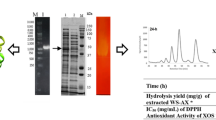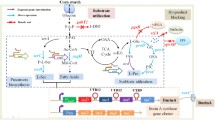Abstract
Xylose reductase (XR) is a key enzyme in xylose metabolism because it catalyzes the reduction of xylose to xylitol. In order to study the characteristics of XR from Candida tropicalis SCTCC 300249, its XR gene (xyll) was cloned and expressed in Escherichia coli BL21 (DE3). The fusion protein was purified effectively by Ni2+-chelating chromatography, and the kinetics of the recombinant XR was investigated. The Km values of the C. tropicalis XR for NADPH and NADH were 45.5 μM and 161.9 μM, respectively, which demonstrated that this XR had dual coenzyme specificity. Moreover, this XR showed the highest catalytic efficiency (kcat=1.44×l04 min−1) for xylose among the characterized aldose reductases. Batch fermentation was performed with Saccharomyces serivisiae W303-lA:pYES2XR, and resulted in 7.63 g/L cell mass, 93.67 g/L xylitol, and 2.34 g/L · h xylitol productivity. This XR coupled with its dual coenzyme specificity, high activity, and catalytic efficiency proved its utility in in vitro xylitol production.
Similar content being viewed by others
References
Amore, R., P. Kötter, C. Küster, M. Ciriacy, and C.P. Hollenberg. 1991. Cloning and expression in Saccharomyces cerevisiae of the NAD(P)H-dependent xylose reductase-encoding gene (Xyl1) from the xylose-assimilating yeast Pichia stipitis. Gene 109, 89–97.
Becker, D.M. and L. Guarente. 1991. High-efficiency transformation of yeasts by electroporation. Methods Enzymol. 194, 182–187.
Bradford, M.M. 1976. A rapid and sensitive method for the quantitation of microgram quantities of protein utilizing the principle of protein-dye binding. Anal. Biochem. 72, 248–254.
Cao, W., Y. Zhou, Y. Ma, Q. Luo, and D. Wei. 2005. Expression and purification of antimicrobial peptide adenoregulin with Camidated terminus in Escherichia coli. Protein Expr. Purif. 40, 404–410.
Hacker, B., A. Habenicht, M. Kiess, and R. Mattes. 1999. Xylose utilisation: cloning and characterisation of the xylose reductase from Candida tenuis. Biol. Chem. 380, 1395–1403.
Hahn-Hagerdal, B., C.F. Wahlbom, M. Gardonyi, W.H. van Zyl, R.R. Cordero Otero, and L.J. Jonsson. 2001. Metabolic engineering of Saccharomyce scerevisiae for xylose utilization. Adv. Biochem. Eng. Biot. 73, 53–84.
Ho, N.W., F.P. Lin, S. Huang, P.C. Andrews, and G.T. Tsao. 1990. Purification, characterization, and amino terminal sequence of xylose reductase from Candida shehatae. Enzyme Microb. Technol. 12, 33–39.
Jez, J.M. and T.M. Penning. 2001. The aldo-keto reductase (AKR) superfamily: an update. Chem. Biol. Interact. 130–132(1–3), 499–525.
Kang, M.H., H. Ni, and T.W. Jeffries. 2003. Molecular characterization of a gene for aldose reductase (CbXYL1) from Candida boidinii and its expression in Saccharomyces cerevisiae. Appl. Biochem. Biotechnol. 106, 265–276.
Kavanagh, K.L., M. Klimacek, B. Nidetzky, and D.K. Wilson. 2002. The structure of apo and holo forms of xylose reductase, a dimeric aldo-keto reductase from Candida tenuis. Biochemistry 41, 8785–8795.
Kuhn, A., C. Van Zyl, A. Van Tonder, and B.A. Prior. 1995. Purification and partial characterization of an aldo-keto reductase from Saccharomyces cerevisiae. Appl. Environ. Microbiol. 61, 1580–1585.
Ladisch, M.R., K.W. Lin, M. Voloch, and G.T. Tsao. 1983. Process considerations in the enzymatic hydrolysis of biomass. Enzyme Microbiol. Technol. 5, 82–102.
Lee, J.K., B.S. Koo, and S.Y. Kim. 2003. Cloning and characterization of the xyl1 gene, encoding an NADH-preferring xylose reductase from Candida parapsilosis, and its functional expression in Candida tropicalis. Appl. Environ. Microbiol. 69, 6179–6188.
Luciane, S., G. Maria, A. Felipe, and S. Silvio 2001. Preliminary kinetic characterization of xylose reductase and xylitol dehydrogenase extracted from Candida guilliermondii FTI 20037 cultivated in sugarcane bagasse hydrolysate for xylitol production. Appl. Biochem. Biotechnol. 91–93, 671–680.
Mayr, P., K. Bruggler, K.D. Kulbe, and B. Nidetzky 2000. D-xylose metabolism by Candida intermedia: isolation and characterisation of two forms of aldose reductase with different coenzyme specificities. J. Chromatogr. B. 737, 195–202.
Mishra, P. and A. Singh. 1993. Microbial pentose utilization. Adv. Appl. Microbiol. 39, 91–185.
Neuhauser, W., D. Haltrich, K.D. Kulbe, and B. Nidetzky. 1997. NAD(P)H dependent aldose reductase from the xylose-assimilating yeast Candida tenuis. Isolation, characterization and biochemical properties of the enzyme. Biochem. J. 326, 683–692.
Nidetzky, B., K. Bruggler, R. Kratzer, and P. Mayr. 2003. Multiple forms of xylose reductase in Candida intermedia: comparison of their functional properties using quantitative structure-activity relationships, steady-state kinetic analysis, and pH studies. J. Agr. Food Chem. 51, 7930–7935.
Oh, D.K. and S.Y. Kim. 1998. Increase of xylitol yield by feeding xylose and glucose in Candida tropicalis. Appl. Microbiol. Biot. 50, 419–425.
Rawat, U.B. and M.B. Rao. 1996. Purification, kinetic characterization and involvement of tryptophan residue at the NADPH binding site of xylose reductase from Neurospora crassa. Biochim. Biophys. Acta. 1293, 222–230.
Verduyn, C., R. Vankleef, J. Frank, H. Schreuder, J.P. Vandijken, and W.A. Scheffers. 1985. Properties of the NAD(P)H-dependent xylose reductase from the xylose-fermenting yeast Pichia stipitis. Biochem. J. 226, 669–677.
Woodyer, R., M. Simurdiak, W.A. Van Der Donk, and H. Zhao. 2005. Heterologous expression, purification, and characterization of a highly active xylose reductase from Neurospora crassa. Appl. Environ. Microbiol. 71, 1642–1647.
Yahashi, Y., H. Horitsu, K. Kawai, T. Suzuki, and K. Takamizawa. 1996. Production of xylitol from D-xylose by Candida tropicalis: the effect of D-glucose feeding. J. Ferment. Bioeng. 81, 148–152.
Yokoyama, S., T. Suzuki, K. Kawai, H. Horitsu, and K. Takamizawa. 1995a. Cloning and sequencing of two xylose reductase genes (xyrA and xyrB) from Candida tropicalis. J. Ferment. Bioeng. 80, 603–605.
Yokoyama, S., T. Suzuki, K. Kawai, H. Horitsu, and K. Takamizawa. 1995b. Purification, characterization and structure analysis of NADPH-dependent xylose reductases from Candida tropicalis. J. Ferment. Bioeng. 79, 217–223.
Author information
Authors and Affiliations
Corresponding author
Rights and permissions
About this article
Cite this article
Zhang, F., Qiao, D., Xu, H. et al. Cloning, expression, and characterization of xylose reductase with higher activity from Candida tropicalis . J Microbiol. 47, 351–357 (2009). https://doi.org/10.1007/s12275-008-0225-9
Received:
Accepted:
Published:
Issue Date:
DOI: https://doi.org/10.1007/s12275-008-0225-9




